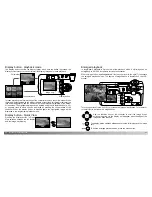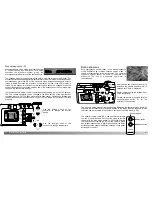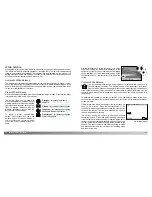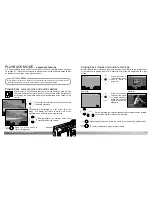
64
65
M
ULTI
-
FUNCTION RECORDING
This camera has autofocus and manual focus control. The focus mode is set in the
custom 1 section of the multi-function recording mode menu (p. 56).
Autofocus will produce excellent results in almost every situation, however, under certain
conditions, the autofocus system will not work accurately; see special focusing situations
on page 27. In these situations the camera can be manually focused.
Focus modes
Single-shot AF
Subject Tracking AF
Single-shot AF focuses on the subject and locks the focus position. This focus mode is
ideal for static subjects. Because the focus is locked when the shutter-release button is
pressed partway down, single-shot AF can be used when the subject is outside the focus
frames, or when a special focusing situation is preventing the autofocus system from
focusing. For more on focus lock, see page 53. The self-timer and remote control drive
mode (p. 38) uses single-shot AF.
Place the subject within the Area-AF focus frames and press the
shutter-release button partway down; Subject Tracking AF will lock
onto the subject and follow the subject’s movement in three-
dimensional space through the focus area; the AF sensors are
displayed to indicate the subject. Subject Tracking AF will not work
with fast moving subjects. This is the primary focus mode in the
auto-recording mode.
Subject Tracking AF will automatically switch to single-shot AF
under very low lighting conditions. Single-shot AF is used with the
self-timer and remote control drive mode (p. 38), the digital zoom,
or when the monitor is turned off (p. 31).
ISO setting
AUTO
100
0.5m ~ 3.4m (1.6 ft. ~ 11.1 ft.)
Flash range (telephoto)
0.5m ~ 2.0m (1.6 ft. ~ 6.6 ft.)
0.5m ~ 2.4m (1.6 ft. ~ 7.9 ft.)
0.5m ~ 1.4m (1.6 ft. ~ 4.6 ft.)
The flash range is measured from the CCD. Because of the optical system, the flash
range is not the same at the lens’ wide-angle position as it is at the telephoto position.
Camera sensitivity - ISO
Flash range and camera sensitivity
Five camera sensitivity settings can be selected: Auto, 100, 200, 400, and 800; the
numerical values are based on an ISO equivalent. ISO is the standard used to indicate
film sensitivity: the higher the number, the more sensitive the film. Camera sensitivity is
set in the basic section of the multi-function recording mode menu (p. 56).
The auto setting automatically adjusts the camera sensitivity to the light conditions
between ISO 100 and 200. When any other setting than auto is used, “ISO” will appear
on the data panel, and “ISO” and the set value will be displayed on the monitor.
A specific sensitivity setting can be selected. As the ISO value doubles, the camera
sensitivity doubles. Like grain in silver-halide film that increases with speed, noise
increases with sensitivity in digital imaging; an ISO setting of 100 will have the least noise
and 800 will have the most. An ISO setting of 400 or 800 may allow the camera to be
hand-held in low-light conditions without the need of a flash. The affect of noise with
exposures of one second or longer is reduced by the noise-reduction function in the
custom 2 section of the setup menu (p. 98).
200
400
800
0.5m ~ 3.4m (1.6 ft. ~ 11.1 ft.)
0.5m ~ 4.8m (1.6 ft. ~ 15.7 ft.)
0.5m ~ 6.8m (1.6 ft. ~ 22.2 ft.)
0.5m ~ 2.0m (1.6 ft. ~ 6.6 ft.)
0.5m ~ 2.8m (1.6 ft. ~ 9.2 ft.)
0.5m ~ 4.0m (1.6 ft. ~ 13.2 ft.)
Flash range (wide angle)
(Continued on the next page)
Summary of Contents for DiMAGE F200
Page 1: ...INSTRUCTION MANUAL E...






























